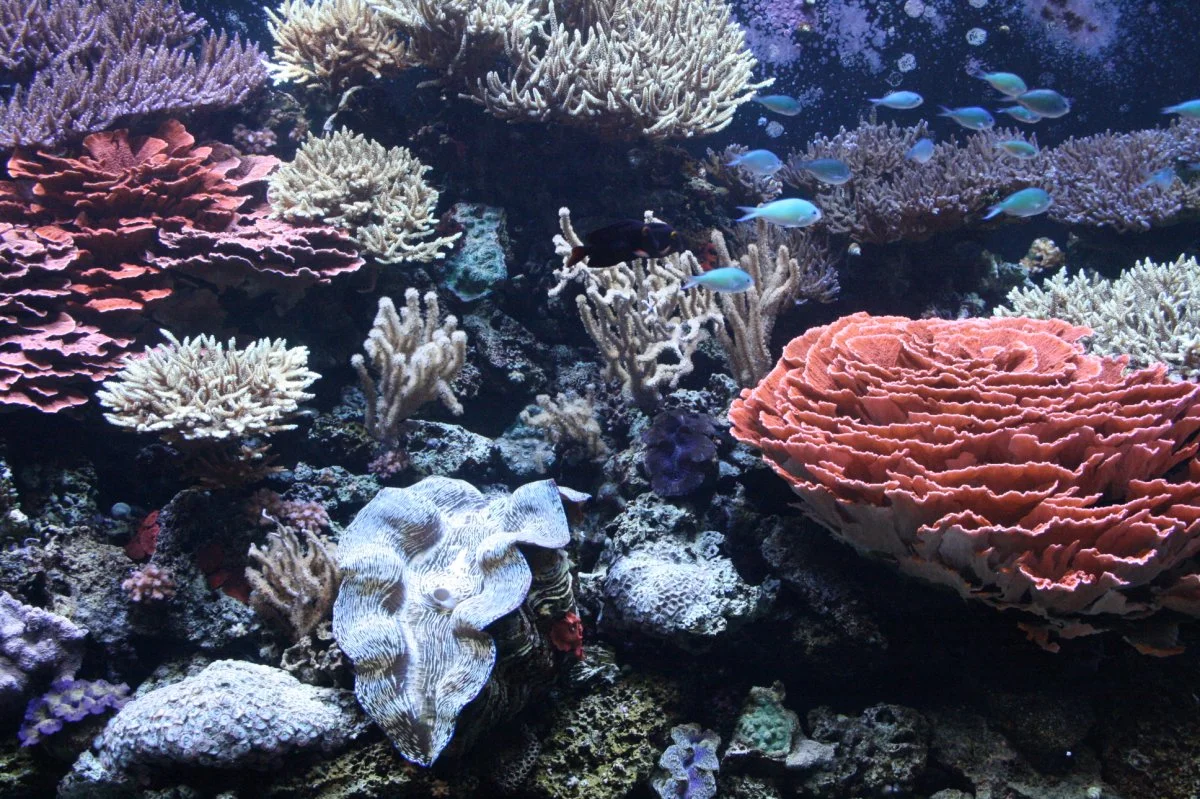Corals are fascinating marine organisms that form highly diverse ecosystems vital to the health of the oceans. Traditionally, they are associated with tropical environments such as Australia's Great Barrier Reef or Caribbean reefs. However, in recent years, a unique and underexplored coral ecosystem has drawn the attention of the scientific community: the corals of the Amazon. In this article, we will examine the importance of these corals, their geographic location and the challenges they face in relation to climate change and human activities.
Amazonian corals are found in the northeast region of Brazil, near the mouth of the Amazon River. Unlike traditional coral reefs, which thrive in clear, tropical waters, these corals thrive in a unique environment: the murky, sediment-rich waters of the Amazon River. Despite apparently unfavorable conditions, the corals of the Amazon form a complex ecosystem rich in biodiversity.
The discovery of the Amazonian corals and the understanding of their unique characteristics were the result of extensive scientific research that involved collaboration between internationally renowned institutions. Initially, the first evidence of the existence of these corals came from oceanographic expeditions carried out in the region in the 1990s. Scientists noticed the presence of coralline structures in areas where only sediments were expected to be found. Intrigued by this unexpected discovery, marine researchers and coral biology experts have turned their attention to this underexplored region.
One of the pioneering researches in this field was conducted by a team led by renowned Brazilian researcher, Dr. Ronaldo Francini-Filho, in collaboration with scientists from the National Institute for Research in the Amazon (INPA) and international institutions. This research, carried out in 2010, used advanced techniques for collecting samples and diving in specific areas of the Amazon region. The team of scientists carefully explored the coral reefs located near the mouth of the Amazon River, using scuba diving and remotely operated submarines (ROVs). Through these expeditions, samples of corals, water and sediments were collected for laboratory analysis.
These analyzes revealed the existence of an impressive diversity of species of corals, sponges, molluscs and other marine organisms, even in turbid waters and with high levels of sediment. In addition, scientists have observed unique adaptations in Amazonian corals, such as a greater tolerance to low light and an ability to filter sediment particles to obtain nutrients.
The results of these surveys were published in renowned scientific journals, arousing the interest of society and drawing attention to the importance of this unique ecosystem. Since then, researchers from different countries have been dedicated to investigating Amazonian corals, deepening knowledge about their ecology, interactions with the environment and their ability to adapt to environmental changes. These observations have been fundamental for understanding the ecological importance of corals in the Amazon, as well as for raising awareness about the need for their preservation. The information obtained through these studies has supported the implementation of conservation policies and appropriate management measures to protect these unique and threatened ecosystems.
Biodiversity and Ecological Importance
The biodiversity of the Amazon corals is remarkable, with the discovery of several rare and endemic species. Among them, freshwater corals stand out, unique in the world, which have the ability to survive in environments with a mixture of fresh and salt water. These freshwater corals are adapted to the specific conditions of the Amazon region, where the Amazon River meets the Atlantic Ocean.
In addition to corals, this Amazonian ecosystem is home to marine sponges of different shapes and colors, some of which are unique to this environment. These sponges play a key role in filtering water and cycling nutrients, contributing to maintaining water quality and ecosystem health. Another rare species found in the corals of the Amazon is the resplendent angelfish (Centropyge resplendens), a species of coralid fish that has vibrant color and is endemic to this region. This species plays an important role in seed dispersal and maintaining the balance of coral reefs.
The ecological importance of Amazonian corals goes beyond their own ecosystem. They play a vital role in the connectivity between marine and terrestrial environments, especially in relation to the Amazon Rainforest. Nutrients from corals are transported by marine currents toward the coast, enriching the coastal region and fueling primary production in these ecosystems. These nutrients are then carried by freshwater into the forest, contributing to soil fertility and influencing rainforest functioning and biodiversity. Amazonian corals also act as an important carbon sink. They capture and store carbon dioxide (CO2) from the atmosphere, helping to mitigate the effects of climate change. It is estimated that Amazonian corals are responsible for capturing around 18 million tons of CO2 annually, contributing to global climate regulation.
The loss or degradation of these coral ecosystems would not only threaten local biodiversity, but would also have negative impacts on the connectivity between marine and terrestrial environments, compromising the functioning of the forest and the sustainability of the region.
Challenges and Threats to the Corals of the Amazon
Oil exploration poses a significant challenge to the preservation of Amazonian corals. The region where these corals are found is rich in natural resources, including oil and gas deposits. The extraction of these resources involves activities such as drilling, building platforms and transporting oil, which can cause direct damage to corals and their habitats.
Oil spills pose an immediate and severe threat to Amazonian corals. Exposure to oil can cause corals to die and impair their ability to recover. In addition, chemicals used in oil exploration and production, such as chemical dispersants, can have toxic effects on corals and associated marine organisms. Pollution caused by oil activities, including improper waste disposal and the release of pollutants into the water, can also negatively affect Amazonian corals. Accumulation of sediments, chemicals and excess nutrients can cause water quality to deteriorate and affect the health of corals and associated species.
It is important to point out that oil exploration in the Amazon region is still a controversial topic. Oil extraction activities are carried out in areas close to Amazonian corals, raising concerns about the environmental impacts and risks associated with operating these activities. Faced with these challenges, precautionary and protective measures are essential. The implementation of strict environmental regulations, the continuous monitoring of oil activities and the adoption of safer and more sustainable technologies are fundamental to minimize the negative impacts on the corals of the Amazon.
Careful planning and a thorough environmental risk assessment are required before authorizing any oil exploration activities in the region. This includes carrying out comprehensive environmental impact studies, public consultation and the participation of the scientific community and stakeholders to ensure that all potential consequences are duly considered.
Need for Conservation and Research
Fortunately, there are real projects underway that aim to conserve Amazonian corals and promote scientific research to increase our knowledge of these unique ecosystems.
One example is the project “Corais da Amazônia”, led by the Museu Paraense Emílio Goeldi in partnership with the Chico Mendes Institute for Biodiversity Conservation (ICMBio), the Federal University of Pará and other research institutions. This project aims to study the biodiversity of corals in the Amazon, investigate their ecology and the impacts of human activities, in addition to proposing conservation and monitoring strategies.
Another important initiative is the “Projeto Reef da Amazônia”, a partnership between Greenpeace Brazil, Instituto Coral Vivo and other institutions. This project seeks to draw attention to the importance of corals in the Amazon and press for the creation of a protected area in the region. Through awareness campaigns, research and mobilization of civil society, the project seeks to involve different actors in the conservation of these corals.
In addition, oil exploration and production in the region has been the subject of debate and questioning. Non-governmental organizations and socio-environmental movements have spoken out against oil exploration near corals in the Amazon, highlighting the risks involved and the importance of prioritizing the conservation of these fragile ecosystems. These projects and initiatives have played a crucial role in promoting awareness of the importance of Amazonian corals, as well as in implementing conservation measures. Through scientific research, monitoring, local community engagement and advocacy, they contribute to the protection of these valuable ecosystems.
International cooperation has been instrumental in these efforts. Several international research institutions have been involved in collaborative studies with Brazilian scientists, sharing knowledge and expertise to advance our understanding of Amazonian corals and propose effective conservation strategies. However, it is important to point out that more investments and actions are needed. It is fundamental that governments, research institutions, non-governmental organizations and society unite to guarantee the conservation of the Amazonian corals and the protection of this unique ecosystem. Only through a collaborative and comprehensive approach will it be possible to ensure the survival of these corals and the maintenance of the rich biodiversity they support.




